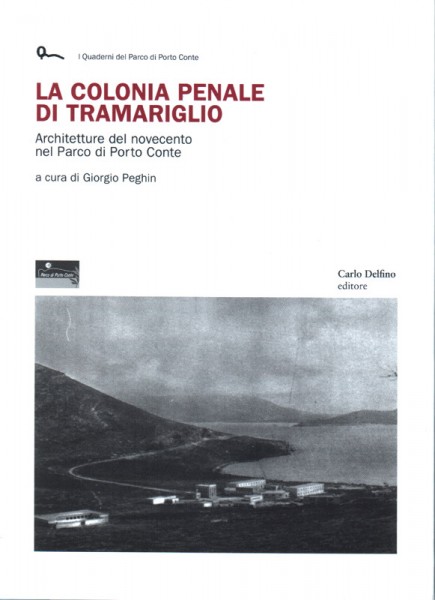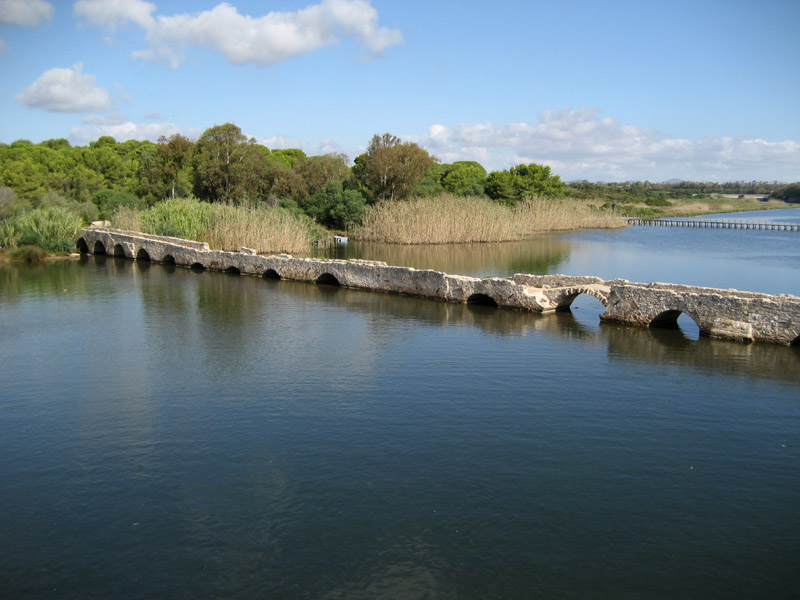The Roman villa of Sant’Imbenia
This archaeological area is located along the road which leads to Capo Caccia, just after the junction on the county road 55 Bis, which goes to Sassari. This area is located in the heart of the roadstead of Porto Conte, in the so-called “Bay of Nymphs” or “Nymphaeus Portus” of Tolomeo. The complex is located right next to the sea, and archaeologists have discovered 49 rooms divided up between an estimated 140 metres in length. Some mosaics are still clearly visible, but many of them have been removed and are now safely exhibited at the National Archaeological Museum “Sanna” in Sassari (at 64, via Roma; Phone nr. 0039.079.272203 – www.museosannasassari.it).
According to archaeologists, the villa was the retreat of a wealthy figure of that period, who dedicated himself to the so-called “otium”, which means the care of the spirit and the pleasures of the body. The extent of the complex and the structures found, however, leads to the presumption that this was a place dedicated also to crop production; benefitting from a privileged position in terms of boarding and maritime trades.
Over the centuries, the villa has undergone various renovations; the different building techniques used are still clearly visible, like the opus caementicium (Roman concrete) and the opus africanum (a sort of African masonry), including masonry in dry stones dating back to the Medieval period.
The part of the villa located furthest to the north, was probably on two floors and in the lowest part a wellness and bathing room, decorated with marbles and sumptuous polychrome decorations, was created. Among these decorations, a stucco representing a Nereid riding a sea animal is of special archaeological and artistic interest. One of the legendary figures is Nereus’ daughter, the marine divinity of Greek mythology, who lived in a cave in the depths of the sea. It is right in the area of Capo Caccia that we find the “Grotta di Nereo” (Cave of Nereus), one of the most important and stunning underwater ravines of the Mediterranean sea, and one of the routes proposed by the tourist centre ArchiMete.
The Nuraghe of Palmavera
Along the coastal road 127 Bis which connects Alghero to Capo Caccia, three and a half kilometres after Fertilia (at kilometre 32), we find the magnificent Nuragic complex of Palmavera. The main keep dates back to the Fifteenth-Fourteenth century B.C., and can be still visited in all its parts; including the large central room with a tholos cupola. Considered the structure of the complex, which was built at the foot of the Doglia Mountain, archaeologists presume that it was surrounded by cabins and refuges. The second cycle of life of the Nuraghe, started after the first half of the Ninth century B.C., when a second keep was added and the first one was covered with blocks of sandstone, a very common material in this area.
The visit is organized between the two towers, and it is also possible to visit the meeting cabin, where there are still a stone bench, a bath and the throne of the tribal chief. During the excavations, archaeologists found several artifacts, which today are mainly exhibited at the National Archaeological Museum “Sanna” in Sassari (at 64, via Roma; Phone nr. 0038.079.272203 – www.museosannasassari.it).
The necropolis of Anghelu Ruju
Prenuragic area of extraordinary importance and the largest in Sardinia. It is located nearby I Piani, along the county road 42, not far from the airport of Alghero-Fertilia. It was discovered by chance in 1903, during the excavations for the building of a farmhouse. The finding of some human bones encouraged further excavations, until crockery, jewels and several hypogean graves were discovered. Over the years, a total of 38 Domus de Janas (Home of the Fairies) were discovered, along with underground graves dating back to three different historic periods: the civilization of Ozieri (3500 B.C.), of the bell-shaped vase (2000-1900 B.C.), and of Bonnanaro (1800 B.C.).
The Tower of Tramariglio
It is, without a doubt, the most important among the several coastal towers in the area of the Regional Park of Porto Conte; dominating the Tramariglio bay and the tourist centre ArchiMete. It was realized in chalky material at the end of the Sixteenth century, during the Spanish dominion. Today, it is still in good conditions, and from the inside, the dome vault and pillar on the terrace are visible, with the holes which allowed light to penetrate the structure.
The Cave of Neptune (Grotta di Nettuno)
It is one of the most stunning places easily reachable by visitors and was discovered by chance by a local fisherman in the Eighteenth century. It is accessible both by sea (departures from the port of Alghero or from the boarding pier of Cala Dragunara, just after the enchanting Tramariglio bay), and by land, through the Escala del Cabirol (Stairs of Roebuck), with its 656 steps running along the cliff, and rising up from the sea, just in front of the Isola Foradada (Foradada Island). The inside is breathtaking and the tourist route winds its way through several rooms, with each one presenting different features: the Lamarmora Lake, an underground salt lake which is 9 metres deep, 100 metres long, and 25 metres wide; with a stalagmite column named Acquasantiera (Stoop) at its center. Another stalagmite rises from the bed of the lake and is called Albero di Natale (Christmas Tree). There are also the rooms of the Reggia (Palace), of the Rovine (Ruins), of the Organo (Organ), of Trine e Merletti (Lace and Lacemaking) and of the Tribuna della Musica (Tribune of the Music), which dominate the room of the Reggia (Palace).
The service of guided visit is available all year long. Visits to the site are possible from Easter to October, from 8 a.m. to 8 p.m. To reach the cave by land, once arrived at the square in Capo Caccia, just read all information on the visit procedures provided on the dedicated wallboard. Instead, to reach the cave by sea, take the motor ship which sails from the port in Alghero.
Further information are available at the tourist office in Alghero (tel. 0039.079.979054).
The Green cave (Grotta Verde)
It is the second most important cave after Neptune, and is located on the eastern side of Capo Caccia. The scenic and huge entrance is at an altitude of around 80 metres; the entire cave is very interesting from a geological, naturalistic and archaeological standpoint, since in the prehistoric age —it is estimated at least 7000 years ago—the cave was already populated by hominids looking for a shelter. On the walls, graffiti and undisputed signs of a human presence are still recognizable; drawings that many still consider shrouded in mystery, and which remain without explication. The natural light which penetrates into the wide entrance hall, allows for the growth of green mosses and lichens on the rocks. This is the feature that gave name to this place.
Imposing stalagmites, which are at least twenty metres high, are clearly visible, and continuing along towards the end of the cave, you reach the underwater part of it, where cave-divers discovered human remains, traces of ancient graves and even Neolithic vases.
The Grotta Verde (the Green Cave) was renamed as “cave of the altar”, because sailors built a small altar inside it dedicated to Saint Erasmo, their patron, back in the Fifteenth century.
Living the history to challenge the future

A headquarters with a long, curious and fascinating history: the structure where the tourist centre of the Tramariglio bay is located (from the Catalan “Tramarill”, meaning “Between two seas”) dates back to the early Forties. The building, in fact, was created as a quarters for soldiers, and specifically for Policemen, who served at the former penal colony. The clearly visible prison of Tramariglio, now open to guided visits, and which is now also the prestigious headquarters of the Regional Natural Park of Porto Conte, was the heart of a small village of convicts, who were employed in draining the Nurra back in 1933. However, Tramariglio was quite a different penal colony, above all, thanks to the goals of the director during that period, who was more focused on the principles of rehabilitation and the redemption of the prisoners, rather than on a hard but useless prison system. And he achieved very important results, because the convicts, in addition to draining the area, also realized important works of reforestation of the area; as well as planting vineyards and pine-eucalyptus, in addition to the ordinary and extraordinary upkeep of this northern-western area of Sardinia. The results of this effort is something that both tourist operators and visitors can still enjoy today, and they are personally asked to respect the nature of this area.
The complex of the former penal colony was decommissioned by the prison administration in 1997, and the bodies which manage the area – the Regional Natural Park of Porto Conte and the Marine Protected Area of Capo Caccia-Isola Piana– allowed for a judicious and careful use of the structures by tourist operators, who were aware of the natural, historical, cultural and rural treasure; real jewels to keep and preserve because they make this part of the island unique.
Between history and culture
.
Click on the image or here to enter the gallery
.
The history of the territory surrounding Alghero is fascinating and extraordinary in many ways. In fact, a period of relaxation in this area is enriched by cultural cues of considerable interest. In a part of the territory, which is not so big, stunning historical and archeological finds dating back to the Prenuragic and Nuragic ages are kept, like the hypogean necropolises of Santu Pedru (Saint Peter) and Anghelu Ruju (Red Angel, or the Devil), along with the Nuragic villages of Palmavera and Sant’Imbenia; all which are easily reachable from the tourist centre ArchiMete.
By clicking on the icons, on the left-hand side of this page, it is possible to know more about the history and other interesting facts about these places; as well as plan your trekking routes surrounded by nature, history, culture and archeology. All this flavored with a touch of adventure. Definitely not a bad deal!
Click on the icons on the left to see more…
.
Where and how to sleep
![]() The tourist centre ArchiMete works with top range facilities of the area; offering convenient and cosy accommodation (SEE ICONS ON THE LEFT) which satisfies every expectation and lifestyle of its customers.
The tourist centre ArchiMete works with top range facilities of the area; offering convenient and cosy accommodation (SEE ICONS ON THE LEFT) which satisfies every expectation and lifestyle of its customers.
Cooperation concerns hotels, apartment hotels, farm holiday facilities and bed & breakfast.
IMPORTANT: For further information please feel free to contact directly the chosen facility (reference to ArchiMete) or send an e-mail to the following e-mail address: archimete@archimete.it , specifying “Info on the stay” in the subject.
Or, call the following phone nr. +39 327 5909300 – +39.333.6744889 – +39.334.9372278 (from 9 to 1 p.m.; and from 2 to 7 p.m.)
Please, before read our privacy policy
Dove e come mangiare
In fase di aggiornamento
Other informations
Search
Category
Tag Cloud
Archive
Febbraio 2022 (1)
Gennaio 2018 (1)
Maggio 2016 (1)
Gennaio 2016 (1)
Giugno 2015 (1)
Marzo 2015 (1)
Febbraio 2015 (1)
Ottobre 2014 (1)
Maggio 2014 (1)
Gennaio 2014 (1)
Ottobre 2013 (1)
Giugno 2013 (1)
Aprile 2013 (1)
Marzo 2013 (1)
Dicembre 2012 (1)
Settembre 2012 (1)
Agosto 2012 (1)
Febbraio 2012 (1)
Gennaio 2012 (2)
Dicembre 2011 (3)
Novembre 2011 (2)
Archimete 2.0

Questo opera è distribuito con licenza Creative Commons Attribuzione - Non commerciale - Condividi allo stesso modo 3.0 Unported.





 RSS Blog
RSS Blog





